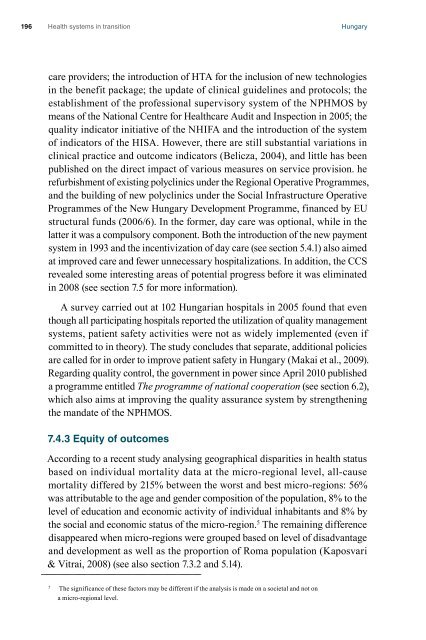Health Systems in Transition - Hungary - World Health Organization ...
Health Systems in Transition - Hungary - World Health Organization ...
Health Systems in Transition - Hungary - World Health Organization ...
You also want an ePaper? Increase the reach of your titles
YUMPU automatically turns print PDFs into web optimized ePapers that Google loves.
196<br />
<strong>Health</strong> systems <strong>in</strong> transition <strong>Hungary</strong><br />
care providers; the <strong>in</strong>troduction of HTA for the <strong>in</strong>clusion of new technologies<br />
<strong>in</strong> the benefit package; the update of cl<strong>in</strong>ical guidel<strong>in</strong>es and protocols; the<br />
establishment of the professional supervisory system of the NPHMOS by<br />
means of the National Centre for <strong>Health</strong>care Audit and Inspection <strong>in</strong> 2005; the<br />
quality <strong>in</strong>dicator <strong>in</strong>itiative of the NHIFA and the <strong>in</strong>troduction of the system<br />
of <strong>in</strong>dicators of the HISA. However, there are still substantial variations <strong>in</strong><br />
cl<strong>in</strong>ical practice and outcome <strong>in</strong>dicators (Belicza, 2004), and little has been<br />
published on the direct impact of various measures on service provision. he<br />
refurbishment of exist<strong>in</strong>g polycl<strong>in</strong>ics under the Regional Operative Programmes,<br />
and the build<strong>in</strong>g of new polycl<strong>in</strong>ics under the Social Infrastructure Operative<br />
Programmes of the New <strong>Hungary</strong> Development Programme, f<strong>in</strong>anced by EU<br />
structural funds (2006/6). In the former, day care was optional, while <strong>in</strong> the<br />
latter it was a compulsory component. Both the <strong>in</strong>troduction of the new payment<br />
system <strong>in</strong> 1993 and the <strong>in</strong>centivization of day care (see section 5.4.1) also aimed<br />
at improved care and fewer unnecessary hospitalizations. In addition, the CCS<br />
revealed some <strong>in</strong>terest<strong>in</strong>g areas of potential progress before it was elim<strong>in</strong>ated<br />
<strong>in</strong> 2008 (see section 7.5 for more <strong>in</strong>formation).<br />
A survey carried out at 102 Hungarian hospitals <strong>in</strong> 2005 found that even<br />
though all participat<strong>in</strong>g hospitals reported the utilization of quality management<br />
systems, patient safety activities were not as widely implemented (even if<br />
committed to <strong>in</strong> theory). The study concludes that separate, additional policies<br />
are called for <strong>in</strong> order to improve patient safety <strong>in</strong> <strong>Hungary</strong> (Makai et al., 2009).<br />
Regard<strong>in</strong>g quality control, the government <strong>in</strong> power s<strong>in</strong>ce April 2010 published<br />
a programme entitled The programme of national cooperation (see section 6.2),<br />
which also aims at improv<strong>in</strong>g the quality assurance system by strengthen<strong>in</strong>g<br />
the mandate of the NPHMOS.<br />
7.4.3 Equity of outcomes<br />
Accord<strong>in</strong>g to a recent study analys<strong>in</strong>g geographical disparities <strong>in</strong> health status<br />
based on <strong>in</strong>dividual mortality data at the micro-regional level, all-cause<br />
mortality differed by 215% between the worst and best micro-regions: 56%<br />
was attributable to the age and gender composition of the population, 8% to the<br />
level of education and economic activity of <strong>in</strong>dividual <strong>in</strong>habitants and 8% by<br />
the social and economic status of the micro-region. 5 The rema<strong>in</strong><strong>in</strong>g difference<br />
disappeared when micro-regions were grouped based on level of disadvantage<br />
and development as well as the proportion of Roma population (Kaposvari<br />
& Vitrai, 2008) (see also section 7.3.2 and 5.14).<br />
5 The significance of these factors may be different if the analysis is made on a societal and not on<br />
a micro-regional level.
















